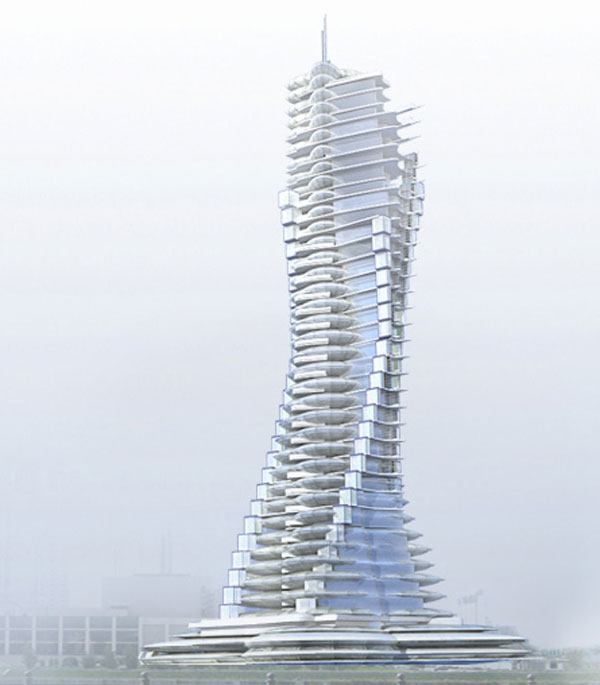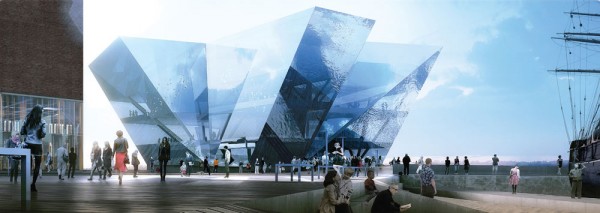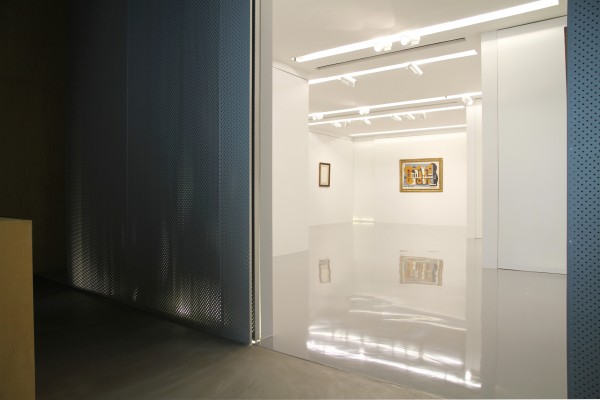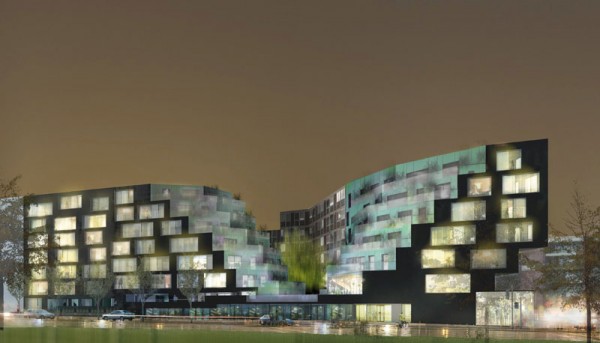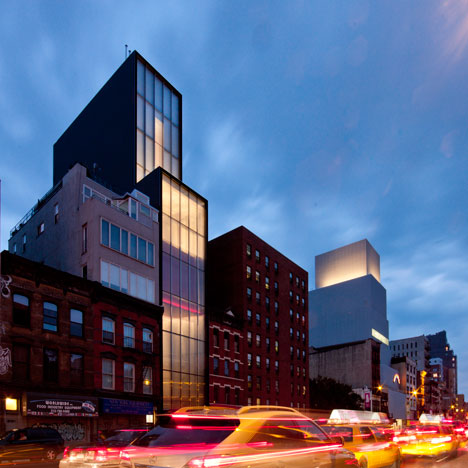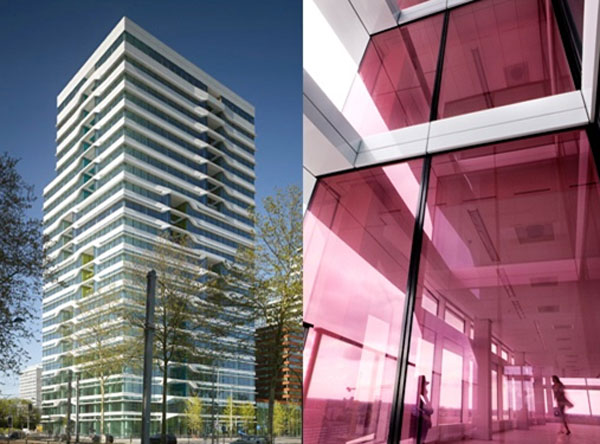Canadian architectural firm Ja Studio submitted a fascinating proposal to the Solar Park South International Competition in Calabria, Italy. The intention of the contest was to re-use the decommissioned highway between Salerno and Reggio Calabria. Ja Studio’s proposal seems to have been inspired by the famous Ponte Vecchio in Florence as an inhabitable bridge. While the famous bridge is home for few families, this new proposal takes the concept to a larger level. The idea was to create a suspended informal city in relationship with the highway and the landscape. It is comprised of a series of random volumes that self-organize to create a large urban network of well defined private and communal areas. Read the rest of this entry »
Modern Ponte Vecchio is an Informal City / Ja Studio
Floating City in Russia
The Eco-techno City is a proposal designed by Russian architect Orzunova Eduardovna as a floating mega-city constructed on top of a complex network of artificial islands. The main recreational and service areas are located in the periphery while the residential hub is located in a 500 feet-high skyscraper. This structure is equipped with vertical farms and diverse green technologies including an undulating façade covered with photovoltaic cells and rainwater collectors located through the vertical parks. Read the rest of this entry »
Low-Income Skyscraper for Developing Nations
Italian architects Diego D’Agostino and Enrica Papa proposed a skyscraper for low-income inhabitants in developing nations. The building consists of a prefabricated steel frame assembled in stages according to population growth. The housing units are designed using recyclable materials including plastic and cardboard collected at local recycling plants. The main idea is to create highly customizable blocks that could expand according to the number of residents. The tower also includes green terraces for vertical farms and recreational areas. An interesting aspect of the proposal is its temporality; the building could be dismantled and transported to new areas according to population needs and economic fluctuations. Read the rest of this entry »
Six Finalists for the Victoria and Albert Design Museum in Dundee
Steven Holl Architects, Snohetta, Delugan Meissl, Kengo Kuma & REX, and Sutherland Husser Architects are the finalists for the new Victoria and Albert Museum in Dundee, Scotland. The Museum will be Scotland’s main institution for design and contemporary art.
The six proposals are currently on display at the University of Abertay Dundee as part of the exhibition “Make it Happen”. Read the rest of this entry »
Edouard Malingue Gallery in Hong Kong / OMA
OMA’s first completed project in Hong Kong opens today: museum-quality exhibition space and offices for the Edouard Malingue Gallery, the city’s first gallery dedicated to Impressionist and Modernist masterpieces.
The design, led by David Gianotten, General Manager-Architect of OMA Asia (Hong Kong), and architect Giulia Foscari, juxtaposes two distinct environments: for the 750 square feet of exhibition space, an articulated sequence of three rooms encased in an aluminium volume visible from the street; for reception and administration, an open office area that reveals the original structure of the building.
The articulation of the three rooms maximises exhibition space and allows viewers time and space for contemplation of individual artworks. The aluminium volume that encloses the three rooms creates a box-within-a-box, serving aesthetic, atmospheric, and practical purposes: the box is visible as an object from Queen’s Road Central below; it creates a sense of protection and seclusion for the viewing of art; and allows for a controlled environment, guaranteeing museum standards for climate, acoustics and lighting. Read the rest of this entry »
Origami-like Brooklyn Center for Digital Creation
The project for the Brooklyn Center for Digital Creation was designed by architect Tobias Eglauer as part of his Master’s Thesis at the Vienna University of Technology with Manfred Berthold as design critic. The project is based on the analysis of folding surfaces in nature such as tree leaves, proteins, insects, etc. It also draws inspiration from traditional Origami folding patterns to create a building that peels from the ground as an exterior recreational landscape that progressively transforms into habitable volumes. The program includes a cultural center, art studios, dormitories, offices, concert hall, library, and retail areas. Read the rest of this entry »
Housing Complex in Lille Evokes Rice Fields Geometry / Saison-Menu Architects
Innovative French architectural firm Saison-Menu unveiled a striking housing project in Lille, France conceived as a series of green terraces based on traditional rice fields in Asia. The segmentation of the building mass produces porous programmatic blocks with a strong sculptural form that will impact the site in an urban and domestic scale. The division between buildings allows for a grand urban opening with recreational areas at ground floor. The residences benefit from excellent views to the city and stunning green terraces that control the air flow and light incidence through the entire complex. Read the rest of this entry »
Sperone Westwater Gallery Opens in NYC / Foster + Partners
Sperone Westwater celebrates the opening of its new gallery on the Bowery in New York with an inaugural exhibition by Argentinean artist, Guillermo Kuitca. Nearly 35 years after its conception, Sperone Westwater continues to exhibit an international roster of prominent artists working in a wide variety of media. Its new building, designed by Foster + Partners, doubles the exhibition area and pioneers an innovative approach to vertical movement within a gallery setting.
Responding to the compact 25 by 100 foot site, one of the features of the project is a 12 by 20 foot moving gallery, which connects the upper four exhibition floors and allows visitors to move gradually between levels. It is a prominent feature along the Bowery, visible from the street, its gentle pace contrasting with the fast-moving traffic. At any given floor, the exhibition space can be extended by parking the moving room as required, with an additional elevator and stairs providing alternative access. Read the rest of this entry »
Mixed-use Tower in Rotterdam’s Harbor
French architect Nicolas Laisne unveiled a mixed-use tower for Rotterdam’s harbor. The building draws inspiration from the industrial area and seeks to become a gateway to the city. Laisne proposes a tower that invites the community to enjoy the waterfront and also serve as symbol to Rotterdam.
The lower levels are used as transportation and commercial hub while the upper floors are offices and recreational areas. An interesting feature of the proposal is the integration of sky gardens conceived as cantilevered platforms equipped with parks, swimming pools, running tracks, sports fields, and restaurants. Read the rest of this entry »
UNStudio Office Tower in Amsterdam Completed
The recently completed 21 storey UNStudio Tower forms part of the Mahler 4 urban complex, a cluster of six buildings located in the heart of the South Axis in Amsterdam. The South Axis connects Schiphol Airport to the major business areas of Amsterdam South.
The Mahler 4 urban complex houses 38.000 m2 of residential spaces, 162.000 m2 of office space and 30.000 m2 of street level retail, cafes, restaurants and a sports centre. The six towers in the Mahler 4 complex range in height from 85 to 100 meters, with each building carrying the name of its designing firm. The Mahler 4 complex has been nominated for the FGH Real Estate Prize 2010.
At a height of 82.5 meters, the UNStudio Tower contains 20 floors of office space and a ground floor with mezzanine. The Royal Bank of Scotland currently occupies 9 floors of the building and the South entrance with commercial space on the Gustav Mahlerlaan. Read the rest of this entry »


